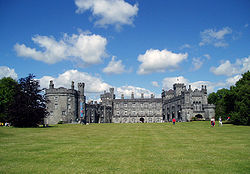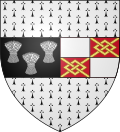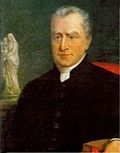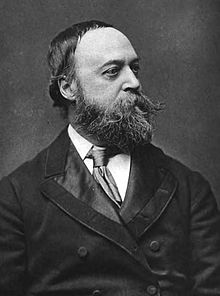Portal:County Kilkenny
The County Kilkenny Portal
County Kilkenny (Irish: Contae Chill Chainnigh) is a county in Ireland. It is in the province of Leinster and is part of the Southern Region. It is named after the city of Kilkenny. Kilkenny County Council is the local authority for the county. At the 2022 census the population of the county was 103,685. The county was based on the historic Gaelic kingdom of Ossory (Osraighe), which was coterminous with the Diocese of Ossory. (Full article...)
Selected articles
Kilkenny (Irish: Cill Chainnigh [ˌciːl̠ʲ ˈxan̠ʲəj], meaning 'church of Cainnech') is a city in County Kilkenny, Ireland. It is located in the South-East Region and in the province of Leinster. It is built on both banks of the River Nore. The 2022 census gave the population of Kilkenny as 27,184, the thirteenth-largest urban center in Ireland.
Kilkenny is a tourist destination, and its environs include historic buildings such as Kilkenny Castle, St Canice's Cathedral and round tower, Rothe House, Shee Alms House, Black Abbey, St. Mary's Cathedral, The Tholsel, St. Francis Abbey, Grace's Castle, and St. John's Priory. Kilkenny is also known for its craft and design workshops, the Watergate Theatre, public gardens and museums. Annual events include Kilkenny Arts Festival, the Cat Laughs comedy festival and music at the Kilkenny Roots Festival.
Kilkenny began with an early 6th-century ecclesiastical foundation within the Kingdom of Ossory. Following the 12th-century Norman invasion of Ireland, Kilkenny Castle and a series of walls were built to protect the burghers of what became a Norman merchant town. William Marshall, Lord of Leinster, gave Kilkenny a charter as a town in 1207. By the late 13th century, Kilkenny was under Hiberno-Norman control. The Statutes of Kilkenny, passed at Kilkenny in 1367, aimed to curb the decline of the Hiberno-Norman Lordship of Ireland. In 1609, King James I of England granted Kilkenny a Royal Charter, giving it the status of a city. Following the Irish Rebellion of 1641, the Irish Catholic Confederation, also known as the "Confederation of Kilkenny", was based in Kilkenny and lasted until the Cromwellian conquest of Ireland in 1649. From 1840 onwards, Kilkenny has not been administered as a city under local government law, but the Local Government Reform Act 2014 provides for "the continued use of the description city". (Full article...)
Selected history articles

The peerage title Earl of Ormond and the related titles Duke of Ormonde and Marquess of Ormonde have a long and complex history. An earldom of Ormond has been created three times in the Peerage of Ireland. (Full article...)
Selected landmarks articles

Kilkenny Castle (Irish: Caisleán Chill Chainnigh pronounced [ˈkaʃlʲaːnˠˈçiːl̪ʲˈxan̪ʲiː]) is a castle in Kilkenny, Ireland, built in 1260 to control a fording-point of the River Nore and the junction of several routeways. It was a symbol of Norman occupation, and in its original 13th-century condition, it would have formed an important element of the town's defences with four large circular corner towers and a massive ditch, part of which can still be seen today on the Parade.
In 1967, Arthur Butler, 6th Marquess of Ormonde, sold the castle for £50 to the Castle Restoration Committee for the people of Kilkenny. The castle and grounds are now managed by the Office of Public Works, and the gardens and parkland are open to the public. The Parade Tower is a conference venue. Since 2002, ceremonies for conferring awards and degrees on the graduates of the Kilkenny Campus of the National University of Ireland, Maynooth, have been held at the castle. (Full article...)
Selected geography articles
The barony of Knocktopher (Irish: Cnoc an Tóchair, meaning ''Hill of the Causeway'') is a barony in the west of County Kilkenny, Ireland. The barony is 46,765 acres (189.25 km2) in size. There are 16 civil parishes made up of 125 townlands. It is one of 12 baronies in the county. The chief town is Mullinavat and it contains the settlements of Stonyford, Ballyhale, Hugginstown, Knocktopher, and Dunnamaggan. The M9 motorway bisects the barony. (Full article...)
Windgap (Irish: Bearna na Gaoithe, meaning 'the wind gap'), is a village in County Kilkenny, in Ireland. Windgap is located in the south-western part of Kilkenny on the border with Tipperary, just south of Callan. The village is located on the R689 regional road, the nearest main road being the N76 from Kilkenny to Clonmel. (Full article...)
The River Nore (Irish: An Fheoir [ə ˈn̠ʲoːɾʲ]) is one of the principal rivers (along with the River Suir and River Barrow) in the South-East Region of Ireland. The 140-kilometre-long (87 mi) river drains approximately 2,530 square kilometres (977 sq mi) of Leinster and Munster, that encompasses parts of three counties (Tipperary, Laois, Kilkenny). Along with the River Suir and River Barrow, it is one of the constituent rivers of the group known as the Three Sisters. (Full article...)
The Nore Valley Way is a long-distance trail under development in County Kilkenny, Ireland. When completed it will be 34 kilometres (21 miles) long and begin in Kilkenny City and end in Inistioge. It is designated as a National Waymarked Trail by the National Trails Office of the Irish Sports Council and is managed by Trail Kilkenny, a group made up of representatives of Kilkenny County Council, County Kilkenny LEADER Partnership, Kilkenny Sports Partnership and local landowners. Two stages are open at present: the first from Kilkenny to Bennettsbridge and the second from Thomastown to Inistioge. The final section – linking Bennettsbridge and Thomastown – is under construction. (Full article...)
Selected quotation
"Fire without smoke, Air without fog, Water without mud, Land without bog."
|
— Unknown, circa 17th Century |
Selected Did you know

- ... that the Black Abbey in Kilkenny was one of the first houses of the Dominican Order in Ireland?
- ... that the earldom of Ormond was originally created in 1328 for James Butler? (Full article...)
Selected slideshow image
Selected biography articles
Hamilton John Agmondesham Cuffe, 5th Earl of Desart, KP, KCB, PC (30 August 1848 – 4 November 1934) was an Irish peer and barrister. (Full article...)
John O'Donovan (Irish: Seán Ó Donnabháin; 25 July 1806 – 10 December 1861), from Atateemore, in the parish of Kilcolumb, County Kilkenny, and educated at Hunt's Academy, Waterford, was an Irish scholar of the Irish language. (Full article...)
William Gorman Wills (28 January 1828 – 13 December 1891), usually known as W. G. Wills, was an Irish dramatist, novelist and painter. (Full article...)
Hubert Marshal Butler (23 October 1900 – 5 January 1991) was an Irish essayist who wrote on a wide range of topics, from local history and archaeology to the political and religious affairs of eastern Europe before and during World War II. He also travelled to Nazi Austria on his own initiative and at his own expense and helped save Jews from being sent to concentration camps. (Full article...)
Selected sport articles
Henry Shefflin (born 11 January 1979) is an Irish hurling manager and former player who was the manager of the Galway senior hurling team from 2021 to 2024. In his playing career he was nicknamed "King Henry" because of his directive style, dominance, competitive spirit, and leadership on the field. He is the only player to win 'hurler of the year' three times, in 2002, 2006, and 2012. Cian Lynch is the only other player to win the title more than once, winning it in 2018 and 2021. He is widely regarded as the best player in the history of the game. A versatile forward who started out in the corner, Shefflin made his name in more commanding positions as a centre or full-forward. He is widely regarded to be one of the greatest players in the history of the sport, with many former players, commentators and fans rating him as the number one player of all time.
Raised in Ballyhale, County Kilkenny, Shefflin served an obligatory but underrated hurling apprenticeship at St Kieran's College. He joined the Ballyhale Shamrocks senior team as a goalkeeper at the age of 17 in 1996 and spent the next 21 years as one of the club's key outfield players. He is one of only a handful of men to have won the All-Ireland Club Championship as a player and as a manager. Shefflin's association with Kilkenny began as a member of the minor team in 1996. He progressed through the under-21 and intermediate ranks before making his senior debut in 1999. Shefflin brought his 18-season association with the black and amber jersey to an end when he announced his inter-county retirement on 25 March 2015. (Full article...)
Related portals
Associated Wikimedia
The following Wikimedia Foundation sister projects provide more on this subject:
-
Commons
Free media repository -
Wikibooks
Free textbooks and manuals -
Wikidata
Free knowledge base -
Wikinews
Free-content news -
Wikiquote
Collection of quotations -
Wikisource
Free-content library -
Wikiversity
Free learning tools -
Wikivoyage
Free travel guide -
Wiktionary
Dictionary and thesaurus

































































